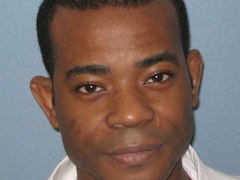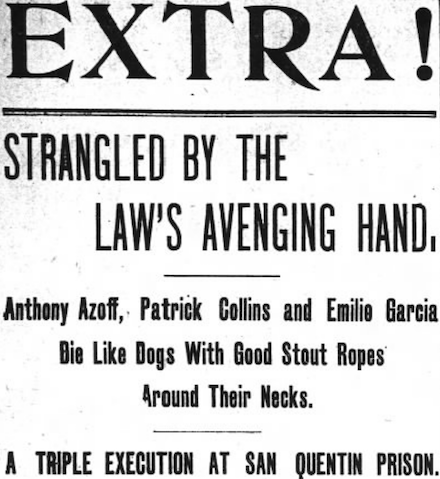On this date in 1739, two French youths were executed by musketry in the French Louisiana colony for the murder of two Choctaws — a gesture of juridical diplomacy that didn’t work out as the musketeers hoped.
Our source for this unusual event is Patricia Galloway’s “The Barthelemy Murders: Bienville’s Establishment of the ‘Lex Talionis’ as a Principle of Indian Diplomacy” from the Proceedings of the Meeting of the French Colonial Historical Society, Vol. 8 (1985). The “Bienville” of Galloway’s title was Jean-Baptiste Le Moyne de Bienville, the French Colonial Governor of Louisiana. It was a post he had held intermittently since 1701, which was back when he and his brother Iberville were still exploring the region.*
Bienville was noted for his deft touch with the native inhabitants of the colony he proposed to govern; in Galloway’s words, he “seemed to have an intuitive grasp of the Indian concept of honor and to understand tribal power structures as no other governor did. In addition, he made it his business to learn and use Choctaw or the Choctaw-like Mobilian trade language in his dealings with the Indians — the only governor to do so.”
Be he ever so empathic, Bienville had a sticky wicket with this case of international violence, when each of the nations involved would have disposed of it very differently had it been a purely internal affair.
On the side of the Choctaw and indeed for all of the tribes of the southeast, the available evidence points to blood vengeance as the accepted response to homicide, but there was no governmental institution to carry it out, so the responsibility for the execution of a murderer fell upon the relatives of the victim … the European notion depended upon handing over regulatory powers to a legal institution; the Indian notion, on the other hand, assumed that familial sanctions would keep individuals in line.
It was a situation that demanded the full measure of Bienville’s diplomatic acumen. The Choctaw people were the largest of several native nations in the French colony, dominating the territory of the latter-day state of Mississippi. Years before the events in this post, Bienville had put them on his team by arming them against the British-allied Chickasaw … but in the late 1730s, Bienville was coming off a failed campaign against the Chickasaw, and with the British making diligent trading inroads with the Choctaw, it wasn’t necessarily a given that they would stick within the French sphere of influence. Indeed, there was a chief of rising stature within the Choctaw nation named Red Shoe whose calling card was pushing a bro-British turn.
Onto this delicate stage barged two Creole half-brothers, whom Galloway identifies as Philippe Alexandre (born in 1710) and a youth of whom we know only the surname Barthelemy (born in 1723): as Barthelemy was the name of the (step-, to Philippe) father who stood patriarch to the whole family, it’s the name by which the affair is known. According to the notes taken on the trial** by the colonial official Etienne Salmon as quoted by Galloway, their crime was motivated by nothing but opportunism and racial animus.
They went in a pirogue from Mobile to the Pascagoulas with a Negro slave to look for some food supplies, and there they found a Choctaw and his wife who were proposing to go to Mobile to trade some bear oil and a few deerskins, and who asked them for passage which they granted them. Contrary winds having cast them ashore on some neighboring islands, they went hunting there. The elder of the two brothers proposed to the Negro that he kill the husband and wife, saying that the savages were dogs, and that if they ran across Frenchmen in the same straits in their country they would not object to killing them. The Negro having rejected the proposition, saying that he had [no] reason at all to kill them, that they had done him no wrong, the two brothers discussed the same thing, and the elder told the younger that he would be doing a valorous deed, and that he would be regarded as a true man, if he made the attack; this child allowed himself to be so persuaded that on the following day at sunrise, while everyone was sleeping, or pretending to, the younger shot twice at the husband and his wife, and killed them.
This happened sometime during 1738. It took some months for the disappearance of these hunter-traders to become known to their communities, and for suspicion to fix on the young men involved. The French colony arrested the culprits and Bienville promised his allies “that justice would be done and would be carried out in Mobile before their appointed witnesses.” For Bienville, this meant the strict application of lex talionis through the French judicial mechanism.
The trial took place on January 10 … the two young men were condemned to die, while the Negro was dismissed as guiltless. The original sentence called for hanging, but to spare the dignity of the boys’ family it was changed to death by a firing squad. Salmon reported that the younger brother had no notion of guilt and was convinced that in the dangerous times then prevailing, he had performed a deed worthy of praise. Even Salmon believed that had the situation been different Bienville would have allowed the younger to escape death. But this was not to be, and the young men were returned to Mobile for execution, which took place before Choctaw witnesses on January 14.
The executions placated the Choctaw and, Bienville hoped, established an understanding that crimes between their nations would be properly satisfied by the offender’s nation more or less on the basis of lex talionis: an orderly and reciprocal life-for-a-life punishment.
Seven years ahead and Bienville had been retired to France when at last there came a Choctaw-on-Frenchmen murder to test the precedent. The new governor, Pierre de Rigaud de Vaudreuil, invoked the principle of this Barthelemy case: “We ask nothing of you but justice, since M. de Bienville had justice done you in 1740 [sic] for a man and woman that some Frenchmen had killed.”
The trouble that the French encountered here in having their claim recognized lay in their failure to understand the distinction made by the Choctaw between domestic and international law in a homicide case. The evidence is quite clear that the Choctaw were prepared to accept the notion of setting off the French deaths by an equal number of Choctaw deaths, but they expected the French, as the injured party, to carry out the killings themselves. If the French wanted the Choctaw to carry out the killings, they said, the French would have to persuade close relatives of the required victims to do it, or else there would be an unending train of vengeance set loose in the nation.
The French didn’t know who had actually murdered their three people and “the usual procedure in such cases was to substitute people who were of little use to the tribe or who for some reason already deserved death.” However, the French greedily bid for a political coup by demanding not a marginal victim but the pro-British chief Red Shoe himself. Unsurprisingly, they didn’t find any of Red Shoe’s relatives willing to turn executioner. The only thing left for the Choctaw to try was
killings committed against a group that was the enemy of both French and Choctaw. Therefore, to set off the deaths of three Frenchmen at the hands of pro-English Choctaws, the pro-French Choctaws attempted to fulfill the French demands in part by killing English traders. This was done in a raid on an English convoy which was being escorted by Red Shoe. After Red Shoe was murdered by stealth, two Englishmen were killed in an open attack, making up the required three deaths.
The French, however, completely missed the point of the Choctaw restitution and refused the two English scalps, insisting on two more Choctaw deaths … The deaths of the Englishmen did not go without notice on the pro-English side. Doubtless as a result of a symmetrical demand by the English, the [pro-English] Choctaw killed five French settlers on the Mobile River. These killings were followed by retaliatory raids by French-allied Choctaws on English trade convoys, killing two more English traders.
This is precisely the sort of blood vengeance spiral that Bienville had been trying to militate against, and it soon pulled the whole Choctaw nation into an outright civil war that killed some 800 people and brought the French into the field as well. Galloway once again:
Bienville’s intentions were good, and it is to the credit of the French that they carried out the execution of the half-brothers, against their inclinations, because this was the kind of justice that the Choctaw understood. Nor are the French to be blamed for expecting the Choctaw to make the same kind of concession to their notion of justice. The tragedy arose not because the Choctaw did not want to render justice at all, but because they had no vicarious legal mechanism to carry it out. In the end, therefore, they were forced into civil war because vengeance carried out by a Choctaw, on another Choctaw, in behalf of a third party not a Choctaw, did not leave the avenger free of punishment himself. Like other aspects of southeastern Indian culture, this one was so inconsistent with European understanding that it had to adapt or disappear, and although it did not actually disappear among the Choctaw themselves until 1823, the principle in dealings with white nations was firmly asserted in treaties from the time of the end of the Choctaw civil war. The Choctaw had dearly bought comprehension of Bienville’s principle with the weighty currency of culture change.
* Iberville and Bienville co-founded Fort Louis de la Mobile (present-day Mobile, Alabama) in 1702; this is where the executions in this post occurred. Bienville founded New Orleans in 1718.
** No original record of the trial survives; Salmon’s recollection is the best we’re going to do for primary sourcing.
On this day..


 Woods and Kerry Spencer — a co-defendant who is awaits execution for the same affair — were in a Birmingham trap house when officers Charles Bennett, Harley Chisholm III, Carlos Owen and Michael Collins arrived to serve a warrant. Of the four, only Collins would outlive the
Woods and Kerry Spencer — a co-defendant who is awaits execution for the same affair — were in a Birmingham trap house when officers Charles Bennett, Harley Chisholm III, Carlos Owen and Michael Collins arrived to serve a warrant. Of the four, only Collins would outlive the 





 White had fatally shotgunned his estranged wife but by now it’ll hardly be remembered beyond the people directly touched by this horror. Yet in its banality this case haas something to tell us about America’s shambolic death penalty system.
White had fatally shotgunned his estranged wife but by now it’ll hardly be remembered beyond the people directly touched by this horror. Yet in its banality this case haas something to tell us about America’s shambolic death penalty system.



